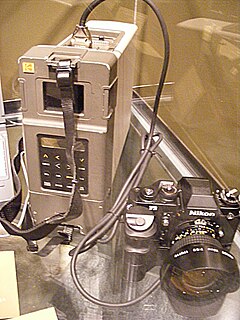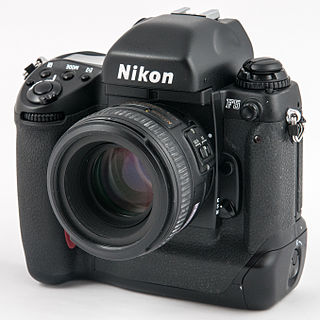The Foveon X3 sensor is a digital camera image sensor designed by Foveon, Inc., and manufactured by Dongbu Electronics. It uses an array of photosites that consist of three vertically stacked photodiodes. Each of the three stacked photodiodes has a different spectral sensitivity, allowing it to respond differently to different wavelengths. The signals from the three photodiodes are then processed as additive color data that are transformed to a standard RGB color space.

A digital single-lens reflex camera is a digital camera that combines the optics and the mechanisms of a single-lens reflex camera with a digital imaging sensor.
The Kodak Professional DCS Pro SLR/n is a 13.5 megapixel full-frame 35mm digital SLR produced as a collaboration between Nikon Corporation and Eastman Kodak. It was an improved version of the Kodak Professional DCS Pro 14n series, and was based on a modified Nikon N80 film SLR and thus compatible with almost all Nikon F mount lenses. The camera was announced in early 2004 and became available to purchase mid-year. A monochrome variant named Kodak Professional DCS Pro SLR/n m of the camera existed as well.

The Canon EOS 5D is a 12.8 megapixel digital single-lens reflex (DSLR) camera body produced by Canon. The EOS 5D was announced by Canon on 22 August 2005, and at the time was priced above the EOS 20D but below the EOS-1D Mark II and EOS-1Ds Mark II in Canon's EOS digital SLR series. The camera accepts EF lens mount lenses.

The Kodak Professional DCS Pro SLR/c is a 13.5 megapixel digital SLR camera produced by Eastman Kodak. It is full frame—it uses an image sensor that is the full size of a 35 mm frame. It is compatible with Canon EOS lenses. The camera was launched on March 18, 2004 and incorporates the internal systems of the previous Nikon-compatible SLR/n in a Sigma SA9 SLR body.

The Nikon D1 is a digital single-lens reflex camera (DSLR) made by Nikon Corporation introduced on June 15, 1999. It featured a 2.7-megapixel image sensor, 4.5-frames-per-second continuous shooting, and accepted the full range of Nikon F-mount lenses. The camera body strongly resembled the F5 and had the same general layout of controls, allowing users of Nikon film SLR cameras to quickly become proficient in using the camera. Autofocus speed on the D1 series bodies is extremely fast, even with "screw-driven" AF lenses.
The Contax N Digital was a six-megapixel digital SLR camera produced by Contax in Japan. The camera was announced in late 2000, and began to be sold in spring 2002, after several delays. The camera received mixed reviews from the press, and was withdrawn from the market within a year of its introduction.

A full-frame DSLR is a digital single-lens reflex camera (DSLR) with a 35 mm image sensor format. Historically, 35 mm was considered a small film format compared with medium format, large format and even larger.

The Kodak Professional Digital Camera System or DCS, later unofficially named DCS 100, was the first commercially available digital single-lens reflex (DSLR) camera. It was a customized camera back bearing the digital image sensor, mounted on a Nikon F3 body and released by Kodak in May 1991; the company had previously shown the camera at Photokina in 1990. Aimed at the photo journalism market in order to improve the speed with which photographs could be transmitted back to the studio or newsroom, the DCS had a resolution of 1.3 megapixels. The DCS 100 was publicly presented for the first time in Arles (France), at the Journées de l'Image Pro by Mr Ray H. DeMoulin, the worldwide President of the Eastman Kodak Company. 453 international journalists attended this presentation, which took place in the Palais des Congres of Arles.

The Canon EOS D30 is a discontinued 3.1-megapixel professional digital single lens reflex camera (DSLR) body, initially announced by Canon on May 17, 2000. It is part of the Canon EOS line of cameras and uses the EF lens mount. The EOS D30 was Canon's first "home grown" digital SLR. Before that point Canon had a contract with Kodak to rebrand the Kodak 2-megapixel DCS 520 as Canon EOS D2000 and the 6-megapixel DCS 560 as Canon EOS D6000 digital SLRs, which combined Kodak digital backs and Canon camera bodies.

The Kodak DCS 400 series was a series of Nikon based digital SLR cameras with sensor and added electronics produced by Eastman Kodak. It was part of Kodak's DCS line.

The Nikon F5 is a 35 mm film-based single-lens reflex camera body manufactured by Nikon from 1996 through 2004. It was the fifth in Nikon's professional film camera line, which began in 1959 with the Nikon F. It followed the Nikon F4 of 1988, which had introduced in-body autofocus to Nikon's professional line. The F5 was in turn succeeded by the Nikon F6, as well as Nikon's parallel range of professional digital SLRs, beginning with the Nikon D1.

The Canon EOS-1D is a professional digital single-lens reflex camera launched in November 2001 as part of Canon's flagship EOS-1 series. It was the first digital camera in the EOS-1 line, succeeding Canon's final flagship film camera, the 1V. It was also the first professional-level digital camera developed and released entirely by Canon, the previous D2000 being a collaborative effort with Kodak. It has a 1.3x crop factor with a CCD image sensor sourced from Panasonic. The camera shares its body design with the Canon EOS-1V 35mm camera. It was complemented by the slower, higher-resolution 1Ds in 2002 and succeeded by the 1D Mark II in April 2004.

The Nikon F90 is a 35mm SLR camera manufactured between 1992 and 2001 and replaced the earlier Nikon F-801. At the time of its release it was noted for its fast autofocus speed compared to previous Nikon models, which had lagged behind competitor Canon's. It was thus seen by many as a 'stop-gap' measure to prevent the mass migration of many Nikon-using professional photographers to Canon, as Nikon's next fully professional camera, the F5, was some time away from release. The Nikon F4, the professional model available at the time of the F90's release, had very slow autofocus compared to Canon's autofocus SLRs.

The EOS-1Ds Mark III is a digital SLR camera body by Canon designed for professional photographers. The Canon EOS 1Ds Mark III is successor to the EOS-1Ds Mark II and was announced in August 2007. The camera features a full-frame 21.1 megapixel CMOS sensor with 14-bit analog/digital converters for a total colour depth of 16,384 tones per pixel. It features a three-inch (76 mm) LCD screen, capable of "Live View," and dual DIGIC III processors allowing it to shoot at up to five frames per second.

The Nikon D3 is a 12.0-megapixel professional-grade full frame (35 mm) digital single lens reflex camera (DSLR) announced by the Nikon Corporation on 23 August 2007 along with the Nikon D300 DX format camera. It was Nikon's first full-frame DSLR. The D3, along with the Nikon D3X, was a flagship model in Nikon's line of DSLRs, superseding the D2Hs and D2Xs. It was replaced by the D3S as Nikon's flagship DSLR. The D3, D3X, D3S, D4, D5, D6, D700, D800, D800Е and Df are the only Nikon FX format DSLRs manufactured in Japan. The D3S was replaced by the D4 in 2012.

The Canon EOS D2000 was a 2-megapixel digital single-lens reflex camera developed by Kodak on a Canon EOS-1N body. It was released in March 1998. It features a CCD sensor and can shoot at 3.5 frames per second. Many enthusiasts regard the D2000 as Canon's first truly usable Digital SLR. It was released in tandem with the Canon EOS D6000, a 6-megapixel model.

The Kodak Digital Camera System is a series of digital single-lens reflex cameras and digital camera backs that were released by Kodak in the 1990s and 2000s, and discontinued in 2005. They are all based on existing 35mm film SLRs from Nikon, Canon and Sigma. The range includes the original Kodak DCS, the first commercially available digital SLR.

The Canon EOS DCS 3 was Kodak's second Canon based Digital SLR camera released in July 1995, four months after Kodak EOS-DCS 5. It uses a modified Canon EOS-1N film camera with a modified Kodak NC2000e digital camera back attached. As a result, it maintained the Canon EF lens mount, and full compatibility with all of Canon's EF lenses made until that time. The camera was followed by the six megapixel Canon EOS DCS 1, which was released later in December 1995.

The Canon EOS 100D, known as the EOS Rebel SL1 in the Americas and EOS Kiss X7 in Japan, is an 18.0-megapixel digital single-lens reflex camera announced by Canon on 21 March 2013. It has been described as the "world's smallest and lightest DSLR camera", either currently in production or in the APS-C format. Canon uses a smaller version of the APS-C sensor format than some other manufacturers including Nikon, Pentax, and Sony, with a crop factor of 1.6 rather than 1.5. It weighs 407 grams including battery and memory card.

















